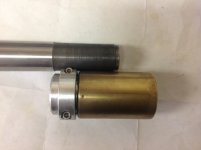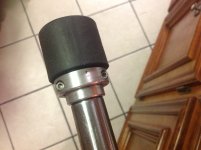Here is mine. One has a rubber lined marine bearing pressed on the tuner body, the other has a piece of hard rubber pressed on. These act as a vibration dampener.
http://benchrest.com/attachment.php?attachmentid=22874&stc=1&d=1568061314
http://benchrest.com/attachment.php?attachmentid=22875&stc=1&d=1568061490
It's a one piece design, it clamps directly to the barrel byway of a .900 36 TPI. The two 6-32 socket head screws secure it.
To make it, take a pice of 1 3/4 aluminum, machine the body and drill and bore it to about .025 inch of the minor thread diameter. The body is 1.155 inch. With a hacksaw, put a slit about 3/4 inch down the body. Put the tuner in a mill, countersink for the pinch bolts, drill through the top half with clearance for a 8/32 screw, then drill and tap the lower. Install the screws, then chuck the tuner back up and thread the ID to .900 36tpi.
Press a 1 1/8 ID marine cutless bearing onto body.
https://www.ebay.com/i/352381907642...MI3eCqkdHE5AIVmv_jBx3CRQcNEAQYCSABEgJE4fD_BwE
To get the desired weight, Machine the brass shell of the bearing to the desired thickness after you attach it to the barrel. (Or Machine a mandrel). My tuners come out to about 5 ounces.
There are multitudes of tuners out there. Some are two piece, some one piece, some have a snubber feature like mine, others don't.
The only two tuners I have personal knowledge of and know they work is the Buky's and the Ezwell.



